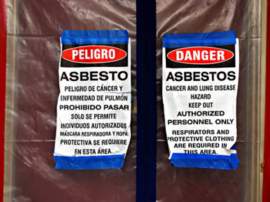
Missouri Asbestos Abatement Procedure

Must Read
Most states delegate the responsibility of enforcing federal mandates on asbestos abatement to a state agency. For the state of Missouri, this state entity is the Missouri Department of Natural Resources. Missouri asbestos abatement procedure focuses on minimizing risks to abatement workers and the environment. In addition, specific guidelines for removal and disposal must be followed to prevent additional, accidental exposure. Sources of asbestos contamination Aside from industrial and construction applications that have led to the sickening of thousands of workers, most homes built before 1980 will have some form of asbestos present. This includes insulation fiber, some paints, plaster and pipes. Some applications are not immediately threatening to the health of occupants, such as ceiling tiles and shingles. For these applications, the asbestos is contained with a sealed, indurate material, such as cement. This application is non-friable, meaning that there is no potential for asbestos fibers to be released and sicken building occupants. Many occupations will also have some danger of working with asbestos materials. Each of these occupations will have specific guidelines for working with asbestos containing materials. This includes asbestos abatement, which has standards for worker licensing, auto mechanics that may encounter asbestos brakes, and workers in public buildings, such as schools, as asbestos materials were prevalent during construction. Notification requirements Any project that will involve greater than 160 square feet, 260 linear feet, or 35 cubic feet of friable asbestos requires a ten working days notification to the DNR. You must also use a licensed contractor that is certified to handle asbestos if this situation is applicable to your structure. Residential buildings under four units are exempt from this regulation, but should have an inspector test and identify possible sources of contamination prior to renovation. Doing so minimizes the risks to your health when you attempt to remove the asbestos. Wetting friable asbestos A critical part of Missouri asbestos abatement procedure is wetting friable materials. Doing so ensures that fibers to not escape and potentially sicken those close to the exposure. When waterlogged, friable materials do not become airborne readily and instead remain mostly intact. When combined with a powerful micro filter, you can effectively make the level of asbestos present in the environment negligible. You will also have the option to encapsulate friable asbestos. This effectively seals the asbestos, preventing further leeching. This has its drawback as it cannot be used on every surface and if the sealant is breeched, you risk contamination. Who may remove asbestos in Missouri? The state of Missouri will license and train professionals in asbestos abatement procedure and other applicable safety precautions. This is typically to the standards and the Occupation Health and Safety Administration. Although there are no statutory requirements for sealing and labeling asbestos containing materials, these professionals will be able to deal with the material appropriately, with minimal risk and proper disposal at an authorized site. Individual sites may have different requirements for labeling hazardous materials. To find an asbestos professional, consult the list of trained professionals available at the DNR website.



















